I was surprised at the quality of game some people were able to make within such a short time and with such little experience. After having played them all, I decided to make reviews and awards for the games.
For the reviews, I’ve divided it into Technicality, Gameplay, Sound, Graphics, Originality, and Overall, all out of a 10.
- Technicality is essentially how bug-free the game is. It also takes into account optimization, or any technical issues the game might have.
- Gameplay is how fun the game is to play. I would try to score of how enjoyable the game would be without any technical issues, because that’s scored previously.
- Sound is all the sound effects and music a game might have from start to finish. Although sound is not technically required, it is always expected unless there is a very good reason not to have it.
- Graphics is what I’m calling this category, but that’s not all it’s being scored on. I’m going to take into account everything visual, which includes menu fonts and backgrounds as well as the overall aesthetics consistency. I’m looking for how everything comes together.
- Originality is how well thought up the concept for the game is. There’s no need to re-invent the wheel, but I would like to see new types of wheels.
- Overall is self explanatory. It’s how every component of the game comes together to create a meaningful experience. It’s not always the sum of its parts.
As for the awards, I made a Best Platformer, Best Shooter, Best Horror, Best Sound, Best Graphics, Most Original, Best Story, Most Polished, Best Overall Game. Some of these will have an honorary mention as well. Games can win multiple awards.
Cake Defense – Corbin
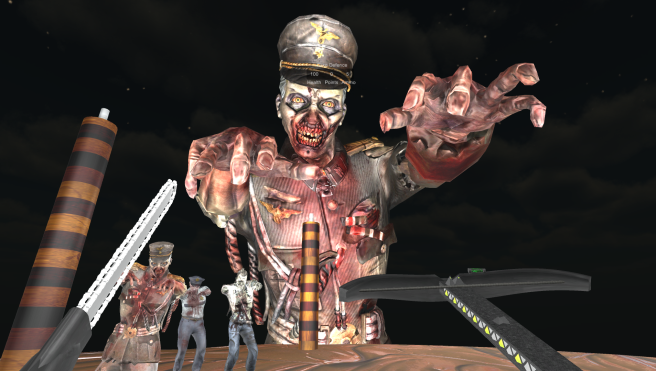
This game felt unfinished on many levels. Before I begin, I do appreciate that this was the work of a single person working with an Engine he had no previous experience with. He also modeled and animated his weapons from scratch. I applaud his enthusiasm, but it should’ve been spent elsewhere. Way too much time was spent on modeling a chainsaw that doesn’t work. The priorities were wrong. Although there weren’t any major game-breaking bugs, there certainly were many annoyances. The game has no start menu and just starts the player off with no explanation. I don’t feel that most people would realize they’re fighting on top of a cake if not for the title. Even if they do, many wouldn’t know the Minecraft reference. There was close to zero feedback when it comes to being attacked and even when attacking. The zombies seem to change form, but continue to chase you. The scoring seemed inconsistent as some gave points while some didn’t. The addition of ammo packs on the ground was essential to the gameplay. Although they shouldn’t look like Sims diamonds, they helped add another layer of gameplay, making it just a little more than randomly spam right click as you go in circles. Soon, there are enough zombies and you gather so much ammo that aiming becomes irrelevant. I feel health should go down in increments while being attacked, not going down continuously upon touch, which isn’t what happens when being attacked by zombies. The number continues after death also. There is no death upon falling off and will just continue falling. It is also possible to land on a small platform which I assume was supposed to be hidden. The zombies properly followed be around except when one spawned on top of another and flew. The only sounds seemed to be the default footsteps and the crossbow. As for the setting, it had an overall dark atmosphere, and the big zombie made things feel more epic as well as assist in figuring out my orientation. This game had some enjoyable elements, but was unable to create an overall enjoyable experience because of the misled focus of this game.
Technicality: 6
Gameplay: 5
Sound: 4
Graphics: 5
Originality: 6
Overall: 6
DabOff – Andrea, Edwin, Imani, Rudy
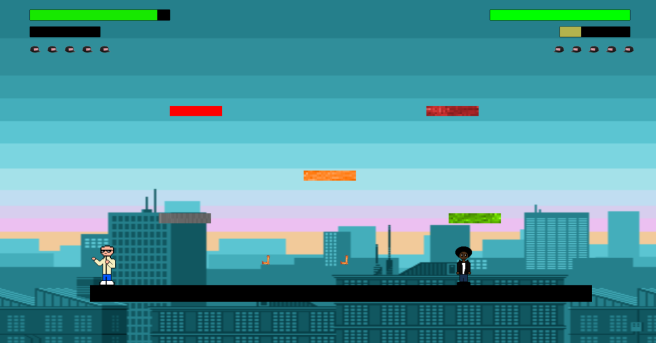
I was excited when I heard about the concept of this game. I was excited when I heard “It’s very clear” as I opened up a smooth looking menu. I was excited when I saw 4 characters to choose from, all with their own Dabbing animations. Everything was crisp up until this point. When I started the game, my excitement weakened a little bit when I saw the health bars and platforms. They were not very pretty, especially compared to what I’ve seen in the menus. After a bit of combat, my excitement died completely. What killed it were the amount of bugs in this game. A game like this, especially in a competitive 1v1 environment needs to run smoothly. (It doesn’t) For a game like this, tight, precise controls as well as smooth movement and clear hitboxes are necessary. Unfortunately, it doesn’t have any of that. The controls and movement are clearly the weakest part of this game that could’ve been fantastic. Because of the way the movement is programmed, players will frequently get stuck because switching left and right as well as firing while moving will break their movements. The jumping is also very glitchy because of this and makes it hard to move horizontally while jumping, making the other platforms hard to reach. Because the players spawn at the bottom platform, and re-spawn from where they die, the other platforms are seldom used. It’s possible to win the game just by standing in place and spamming L’s at the opponent until dabbing is available, at which point they can reach the enemy and kill them over and over again while they spawn at the same place. It was unfortunate that the core gameplay was so uncomfortable to play, because everything else surrounding the game was great. It had a great premise, menus, music, art, and even easy ways to quit and restart the game. I would’ve also liked to hear something harder during the fight, which would set the tone of fast paced adrenaline combat action as well as having that feeling of power. With a soft background music and not much feedback upon being fired and Dabbed at and even killed made the characters feel weak and couldn’t deliver the swiftness and power that a Dab is. I liked that the 4 characters looked unique, I just wished they were given names during selection. It was purely the technicals that brought down this game as it excelled in other aspects.
Technicality: 4
Gameplay: 7
Sound: 7
Graphics: 8
Originality: 8
Overall: 7
Dark Places – Collyn, Yu
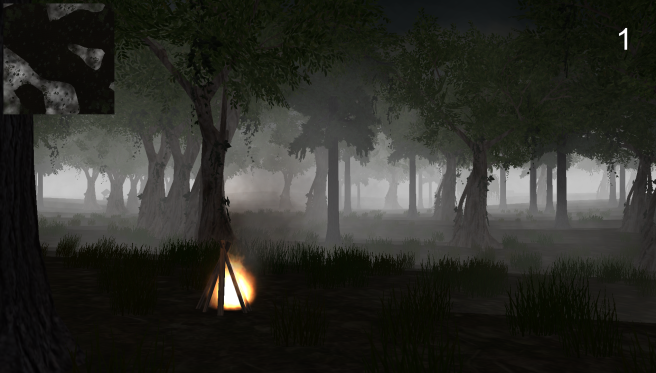
This game had the right things in mind. There are lots of things that went right, and for many things that weren’t so right, it was clear that steps were taken to try to make it right. The only technical issue was limited to the long loading without any notification that it was loading, and the severe lag. Unfortunately, the lag was probably unavoidable by the developers, but it hurt the game. The low frame rates took me out of the game and constantly reminded me that I’m playing a game and that I’m not actually trying to escape this scary place. Besides that, there were no real bugs that hindered the gameplay. Before talking about the core gameplay, the HUD needs to be mentioned. The Ariel font number does no favors for the scary environment. The minimap wasn’t entirely necessary for a game like this, and it wasn’t of much help. The minimap was way more disorienting than just looking at the landmarks in your surroundings. It would’ve helped tremendously to highlight landmarks on the minimap, making it much more useful. It would’ve also helped with the major problem with it’s gameplay. It’s simply dull. I wander around for ages trying to collect all the fires, but they’re very hard to see in this environment. After a while, it becomes less scary and much more tedious. I walk around over and over again trying to find campfires to light. There’s no real sense of escalation as I light more and more. I would’ve loved to have given some hints to the next campfire once I light once so I can feel like I’m actually making progress. The forest isn’t much to look at and it’s pretty easy to get lost, which does help achieve the sense of isolation and anxiety at the cost of it being boring. None of the props are innately scary, just worn down. I do appreciate that there are many unique landmarks to help me get a sense of where I was. The creepy music helped create a spooky environment and set the tone for the game. Being able to see the Reaper at a distance through the fog gave a constant reminder that there are enemies about. However, knowing how to avoid the scary part of the game reduces the scariness of the game. But when within range of the Reaper, the game reminds you that it is a horror game. The Reaper creeps up chanting dark whispers which can be scary to some. They are indicators of the range of the Reaper. This makes sense in terms of being fair. However, horror games are not about being fair. I always know when there’s a Reaper around me and I can simply run out of its range. There’s no constant feeling of dread of thinking I’ll be captured at any moment because I know there’s not a Reaper in range. A warning system like this lets me know I don’t have any jumpscares coming as I always expect it. The only thing I don’t expect are the bear traps which are basically invisible. These things aren’t even scary. They just take you to the menu and that’s it. It feels very unfair, which seems like something they tried to avoid with the Reaper. It would’ve been much scarier to be stuck on a bear trap and have the Reaper approach while you’re stuck. If the Reaper were to do some kind of jumpscare upon contact similar to Slenderman, it would’ve pushed it to the next level. Instead, dying just felt lame rather than scary. This bug-free game achieved creepyness, but was ultimately unable to deliver on real horror and grew rather dull.
Technicality: 8
Gameplay: 6
Sound: 8
Graphics: 9
Originality: 6
Overall: 8
DEFCON 1 – Akshat, Alex, Brandon, Orson

This game was a bold undertaking. There was so much done for this game and was overall very impressive. However, the game lacked in some key areas which needed more focus. It was clear there was a lot of work done, but there wasn’t enough time left to do minor tweaks. Everything was there, but the seemingly lack of QA didn’t allow this game to be perfect. With a simple change of a few numbers, this game could’ve been much more fun. There were a few minor bugs, which is completely understandable for a game with a scale this big. This game was a massive undertaking from start to finish. From the very moment I see the game with a custom icon, I knew this game would be way ahead in terms of tech. The Unity launcher showed custom art along with a controls tab that allowed me to change controls, and even came with joystick controls. It gave a great first impression. I open up to see a custom made image along with fantastic menu music made from scratch. It was really unfortunate that this music didn’t continue into the gameplay, instead we were left with silence in terms of background sounds. The menus weren’t the prettiest, but they worked perfectly and did what it had to. This game definitely gave me the impression of overdoing things. Up to this point of opening up to the main menu, there have been so many appreciated but unnecessary features. There would be many more to come during the gameplay. This is why it’s a shame that the gameplay isn’t perfect, because there are so many extra features and fluff that should’ve been undertaken after. The game opens up to voice acting with subtitles, which was great for the long loading time, which I’m glad they had a loading menu for. Otherwise, the game would’ve just seemed frozen. The voice barely gave an explanation of what’s going on. I wish that instead of a vague narration, it was a mission briefing telling the player what to expect and what to do. As the player is pitched in front of a teleporter, there’s no explanation to why it’s there and where to go and what to do. After the player takes it upon themselves to explore, they’ll see that there’s an entire city on Earth as well as a vast moon landscape. These are both scaled largely, but necessary. In fact, it may have hurt the gameplay as the player is unsure where they are supposed to go. There is no reason to go to certain landmarks as they offer no bonuses like ammo nor do they offer any strategic advantage. With no objective, the player really doesn’t have much to do other than survive, which is very easy if actually tried. The ammo and health seem to refill upon teleportation so the player can simply just teleport back and forth. Survival is very easy as the enemies don’t seem to escalate. There are no waves system and the enemies don’t get stronger or faster. There are no new types of enemies appearing. All the different types of enemies appear from the start and all have the same speeds, just different animations for some. This isn’t really enough to differentiate the different types of enemies. Usually different types of enemies would allow for different types of guns to be used instead of using the same guns over and over again. There’s also inconsistency in numbering the ammo as some list number of ammo left and some list number of magazines left. On the topic of guns, this is probably the best example of ‘more is not better’, which seems to be a common theme throughout the game. There are around 10 guns plus a knife, many of which have the same function. All of them have unique sounds, and a wide array of animations that include shooting, reloading, iron sights, and sprinting. There does not need to be 3 snipers and 3 assault rifles. 4 guns would have been plenty. The knife serves no purpose as the range is dangerously close and there’s practically infinite ammo available. The city has interesting landmarks, but gets lost in the same looking buildings. That and the square roads lead to a rather dull earth level as there are no signs at all of an attack. I would’ve appreciated some cars in the streets to cover up large open areas. This is a major problem on the moon as the player can just stand on top and just snipe every enemy across the map. The emphasis on this game wasn’t ‘let’s make this game fun’. It was, ‘what else can we add?’. Game design wasn’t high enough on the priority list and the game suffered because of it. There were so many extra features (including naming my graphics card in the settings), but the gameplay just wasn’t there.
Technicality: 9
Gameplay: 7
Sound: 8
Graphics: 8
Originality: 8
Overall: 8
Inside – Kira
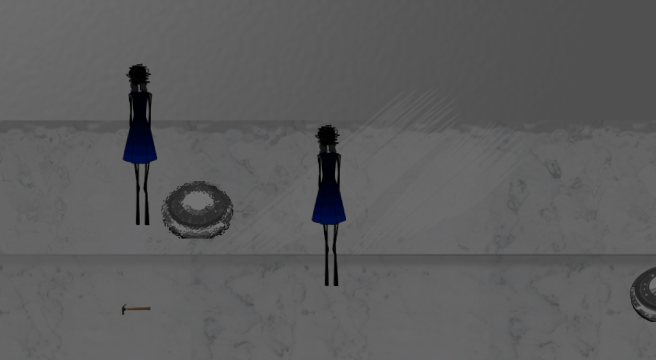
This game is creepy. This is done very effectively because I had no idea what to expect. I had no idea what I had ahead of me. It was unfortunate that the text weren’t disappearing like they were supposed to, but it didn’t take away much from the feel of the game. This game got me emotionally interested as it featured a narrative. The opening menu was a great intro to the rest of the game. It set the premise to what might be ahead, but didn’t give anything away. The gameplay puzzle is absolutely horrifying at first. It’s unfortunate that the game was so short as I would’ve loved to see more. The beginning and end were so good I really wished for a bigger filling in the middle; I would’ve appreciated something more than 1 single puzzle. The puzzle felt puzzly enough, but may be frustrating for some as there were no immediate responses giving us hints that what we’re doing is right or wrong. The fact that we have to press enter while our mouse is hovering over text is a bit annoying because only one of the two is usually necessary. The sounds were appropriate and did what it had to. This was a very short game, but left a lasting impression and made me want to play much more.
Technicality: 7
Gameplay: 7
Sound: 7
Graphics: 8
Originality: 9
Overall: 9
IonBlast – Harry, Kevin, Tommy, Vanguard
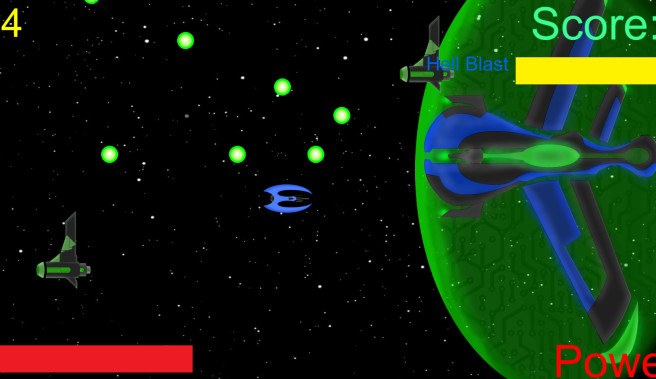 This is probably one of the more uglier games I’ve played. Most of it is because of HUD rather than anything else. Obviously, most of the text is off the screen. It wouldn’t look too much prettier if they were on the screen anyways. The random colors and font just don’t at all match the game. Simply just a little bit of typography skill would’ve made the game look so much better. I’m not sure why the main character ship is duller than the enemies it’s fighting against. The laser is too thin and doesn’t hit targets that are heading straight towards the player ship. The keyboard inputs sometimes gets blocky, but it isn’t too serious. The gameplay is its saving grace. The game is fun. This is a classic sc’mup with very few twists. The only thing I felt was different was the powerups that increased attack power. However, it does nothing against most enemies because they die in one hit. It is only good for fighting the boss, but that isn’t obvious and the player gets punished for not collecting enough at the end. I felt this was a flaw. Simply taking from other games and having it shoot 2 bullets and in multiple directions and having nukes would have been more fun and effective. I would’ve liked the ship to move a bit faster as well. There clearly were different types of enemies, but it wasn’t clear what set them apart. Their movements seemed similar and there was no real different way on playing against them. The difficulty was about right if not a tad bit too hard I felt, meaning it has been playtested. This fun classic game could’ve been saved by its colors and font.
This is probably one of the more uglier games I’ve played. Most of it is because of HUD rather than anything else. Obviously, most of the text is off the screen. It wouldn’t look too much prettier if they were on the screen anyways. The random colors and font just don’t at all match the game. Simply just a little bit of typography skill would’ve made the game look so much better. I’m not sure why the main character ship is duller than the enemies it’s fighting against. The laser is too thin and doesn’t hit targets that are heading straight towards the player ship. The keyboard inputs sometimes gets blocky, but it isn’t too serious. The gameplay is its saving grace. The game is fun. This is a classic sc’mup with very few twists. The only thing I felt was different was the powerups that increased attack power. However, it does nothing against most enemies because they die in one hit. It is only good for fighting the boss, but that isn’t obvious and the player gets punished for not collecting enough at the end. I felt this was a flaw. Simply taking from other games and having it shoot 2 bullets and in multiple directions and having nukes would have been more fun and effective. I would’ve liked the ship to move a bit faster as well. There clearly were different types of enemies, but it wasn’t clear what set them apart. Their movements seemed similar and there was no real different way on playing against them. The difficulty was about right if not a tad bit too hard I felt, meaning it has been playtested. This fun classic game could’ve been saved by its colors and font.
Technicality: 6
Gameplay: 8
Sound: 6
Graphics: 5
Originality: 5
Overall: 7
Piggo – Jennifer, Val
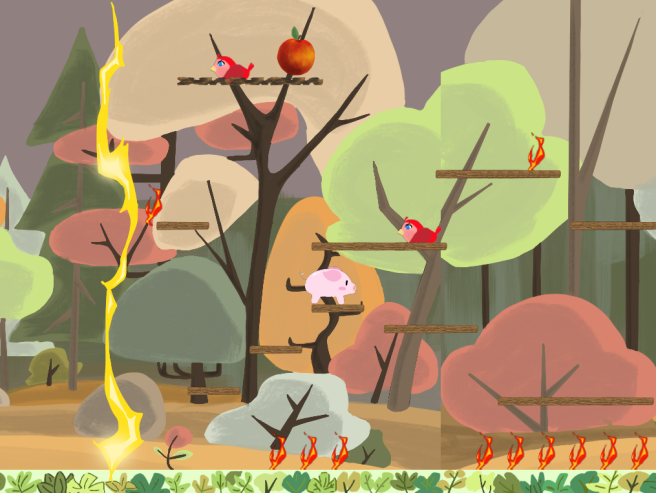
A Piggo is big ol’ Oinker. That being said, this game is good. The only major complaint would be how short the game is. With two short levels, a skilled player would beat this game in seconds. The fact that a player can easily run through this game with skill and not having to deal with any major bugs is great. The movement is very smooth as is necessary in a game like this. The lightning was a bit slow and did nothing, especially if the player was way ahead. There was no need for the apple until the second level seemingly forced the apple onto the player. The numerous platforms give an illusion of choice as there are only a few real possible routes, making this more of a puzzle. The collision with the birds and fire were frustrating at times because their hitboxes are so large the pig dies even when they weren’t even touching visually. The opening menu completely describing every element of the game helped a lot in understanding the game so the player could easily enjoy it. As for the art, it was completely hand drawn from start to finish and looks great throughout. The only real problem here was that some platforms were very hard to see because it was the same color as the wood in the background. Not being able to distinguish from a game object from the background is not fun. There was not enough differentiating the two levels as the background seemed identical. It could easily just have been one single level with a checkpoint. I liked the music, but I would’ve liked it to continue instead of restarting every time you die because it happens often and the music restarts become very noticeable. Otherwise, this is a very smooth and pretty game.
Technicality: 9
Gameplay: 8
Sound: 7
Graphics: 9
Originality: 7
Overall: 8
Rising Sun – Audrey, Brian, Finn, Skylar
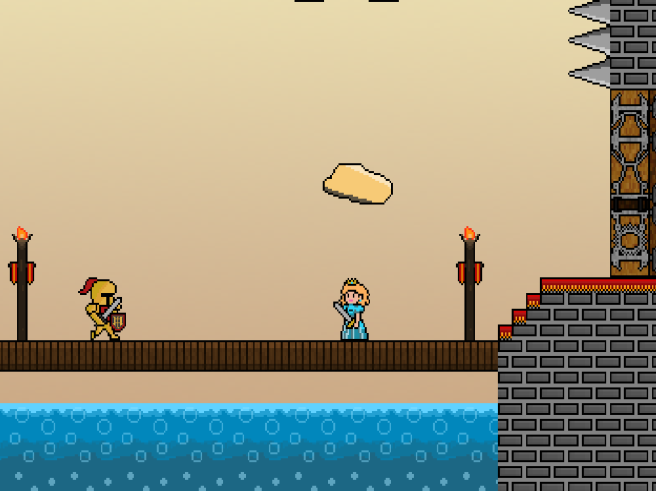
This game is not about Japanese Imperialism. In fact, this game is about so much more, that I’m disappointing more narrative isn’t given in the game. The only thing there is what the player can understand for themselves, which can lead for a lot of confusion. The game is entirely built around a bug they could not fix. It ended up being that the bug was buggy and was very unreliable and at many times frustrating. Although it was fun in places where it worked, it was almost maddening in places where it wouldn’t. Overall however, the levels were well designed and had a very long length compared to the other games. None of it got too old as every level felt unique. The second introduced a new area with lots of new art that wasn’t in the first scene. The third featured a new type of enemy that influenced the entire stage. Even the final scene with the credits where I could still jump on platforms was very cool. Almost everything had a sound effect, but lacked any background sounds. The jump noise felt a bit out of place and got pretty irritating. The art was consistent throughout and did a very good job with the seamless textures laid out everywhere. There was so much extra art that wasn’t essential, but greatly helped with the look of the game. These things includes glass mirrors, clouds, and torches scattered everywhere. This brings the whole game together and makes it feel complete. The only confusing part was the insta-death TNT without an explosion. The overall game feels very filling and complete for the most part.
Technicality: 8
Gameplay: 9
Sound: 7
Graphics: 9
Originality: 8
Overall: 9
Space Crusader – Aaron, Ananth
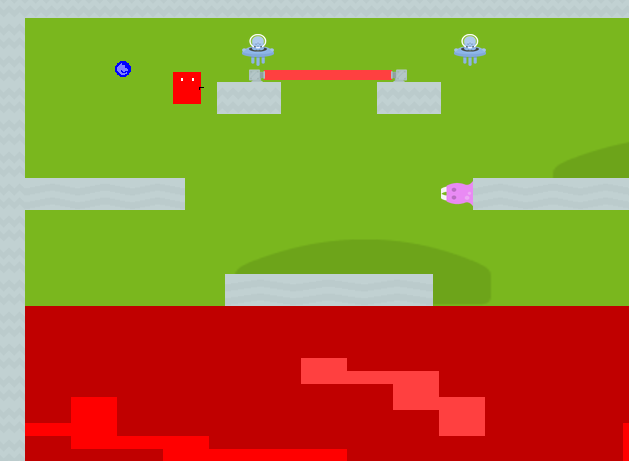
I would’ve felt better if the entire game was just a big joke. However, there are hints that there were efforts made to make this serious. It’s unfortunate that the game ended up being so terrible because the movements were rather solid, which some games were not able to accomplish. I actually love comedy games, so when I opened up the game, I was hoping the rest of the game was going to be as funny. It felt more like they were trying to make a serious game that ended up being hilariously bad instead of trying to make a hilariously bad game. I cringed at the many bugs and horrible art I’ve come across in this very short game. It was one single level with a broken boss that can only be beaten by standing still pretty much. The gun is very weird, which leads to plenty of shots flying where I don’t want them to. Sound is completely nonexistent in this game as well. Some of the higher quality sprites mixed with the lowest quality sprites make the game uglier than it should’ve been. Although the platforming aspect wasn’t terrible, I was overwhelmed by the hilariously unfinished ugly mess that is this game. I appreciate the 3 types of enemies worked fine. I just wished that there were more of them to fight. This game’s process was the opposite of many of the other games. The game mechanics came first, and then the design while many games did the reverse. I would’ve liked them to go all out on the jokey route and just have hand drawn the enemies, which could’ve helped tie the whole thing together.
Technicality: 7
Gameplay: 4
Sound: 2
Graphics: 3
Originality: 6
Overall: 4
Vandeath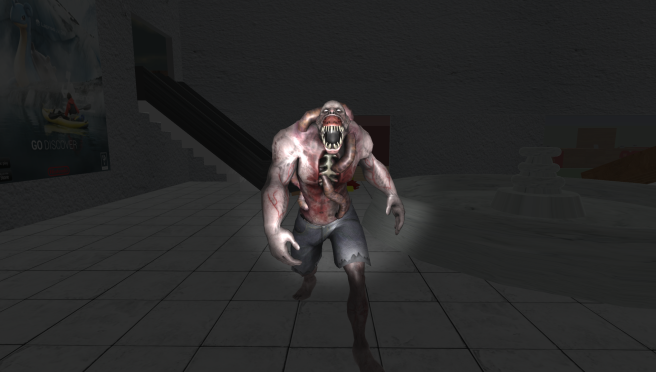
A silent, slow moving enemy with predictable movement isn’t the scariest to face off against. The fact that the monster moves slowly even at a close range and that I’m able to simply outsprint it, didn’t allow for a real scare. The monster being completely silent when it looks like a loud being also took me out of the game. The interior was fairly well designed and had enough to make me believe I was in a store. The scattered props were needed here. It wasn’t the greatest voice acting, but it delivered the much needed setting and objective of the game. The player would have been completely lost without it. The game is a bit short, but it works from start to finish. The main complaint would be that the monster simply isn’t scary enough.
Technicality: 8
Gameplay: 6
Sound: 7
Graphics: 7
Originality: 7
Overall: 7
Awards
Best Platformer – Rising Sun
Honorable Mention – Piggo
Both Rising Sun and Piggo felt like completed games to me. The gameplay was solid and fun on both of them. They both had consistent art all made from scratch. They both also had adequate sounds. Really the main thing that separated the two was the length of the game. Piggo was just way too short and wasn’t satisfying. The two levels have almost nothing different and I feel it could’ve easily been extended to several more levels. Rising Sun on the other hand, had 3 full length levels, each with their own design. Each level felt unique and purposeful. It also helped that there were different types of blocks, different types of enemies, and different types of hazards. Although many of these weren’t necessary because they acted the same way, the variety gave the game a less sense of pure repetition. Rising Sun is also one of the few games that also gave a satisfying ending.
Best Shooter – DEFCON 1
This is an example of a game going above and beyond. Overextending on features means some areas are skimped on. Unfortunately, one of these areas was the actual gameplay. The game has all of the basics down so well, it should’ve perfected what it had instead of adding more things. Movements and shooting was very smooth. Sprinting, jumping, aiming down iron sights, and switching between weapons all felt very seamless. The core mechanics worked so smoothly that it was fun to go around shooting things for a while. Although the fun doesn’t last very long, it was still enjoyable to explore the large set pieces and appreciate taking down 5 different enemy types with 10 different guns. Again, this game had so many little cool features that put it above other games and almost makes up for its gameplay.
Best Horror – Inside
Honorable Mention – Dark Places
Both games were creepy, but Dark Places was a bit too familiar. The feeling of dullness soon overpowers the fear that the game tries to bring. The Reaper was predictable and the campfires were not fun to find. I was not prepared for Inside. It’s new and from start to finish I had absolutely no idea what to expect, which always kept me to the edge of my seat. Although very short, I had a strong feeling of wanting more because of how good it was in its short playthrough. It delivers a sense of horror without feeling like it’s trying too hard. It goes beyond the cliche to deliver emotions beyond horror.
Best Sound -Dark Places
Honorable Mention – DabOff
Both Dark Places and DabOff are games that were helped tremendously with sound. It would not have been anywhere near the same experience without it. DabOff started very strong in the menus, but quickly fell off during the actual gameplay. I just didn’t feel Dab enough while I was playing because the music and sounds simply didn’t deliver on that. Dark Places’s horror mostly comes from its sounds. The scary ambient noise along with the occasional crows keep me on my toes. Things get really scary when the Reaper starts chasing you with its whispers. Dark Places fully utilized sound as a game mechanic as well as an aesthetic and ties everything well together.
Best Graphics – Rising Sun
Honorable Mention – Dark Places
These games delivered on one of the most important aesthetic feature: consistency. The art style was consistent throughout the entire game, which includes any menu and text. (Aside from the number counter in Dark Places) Dark Places had a dark environment littered with broken down props and uneven hills with lakes so that it became so much more than a flat forest with just trees. However, the props didn’t help too much in making the place feel any scarier. Rising Sun had tiles and props that were not essential to gameplay, but its presence makes the setting much more interesting. The game felt very professional because of all the pretty art. It also allowed for lots of variety to keep things interesting throughout.
Most Original – Inside
Honorable Mention – DabOff
I have to admit, I liked the premise of DabOff. I don’t think I know another game centered around a Dab as a primary game mechanic. It was an original reskin of familiar arena combat gameplay. Inside was original from its very premise and gameplay. It was a mixture of a point and click story game with an escape room puzzle.
Best Story – Inside
Honorable Mention – Rising Sun
Inside is the only one that really tried to tell a story game and even falls under the story genre. Some games featured a few lines of voice acting to tell a short story, but it said even less than what Rising Sun showed without any text. The game itself was enough explanation to what was going on and none of it had to be explicitly mentioned.
Most Polished – Piggo
Honorable Mention – Dark Places
Neither of these games had any bugs that effected gameplay, other than the fact that Dark Places was extremely laggy. Both of these were for the most part glitch free and had a smooth experience from start to finish.
Best Overall Game – Inside
Honorable Mention – Rising Sun
These games were great in their own way. Inside is truly a game that delivered a satisfying experience and left a lasting impression. The variety of different tasks as well as the story sucked in my attention. It was a shame that it ended too quickly. Rising Sun on the other hand was the longest game, and managed to grab my attention throughout the whole thing. It is unfortunate that the glitch the whole game revolves around is glitchy even when taken full advantage of, keeping it from being a perfect game.
Ok that’s it tell me what you guys think.



